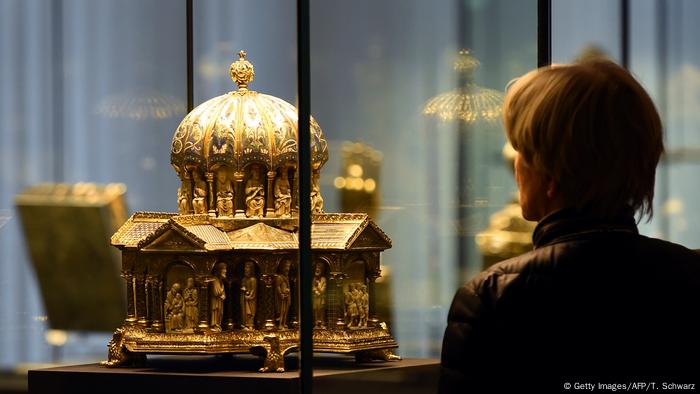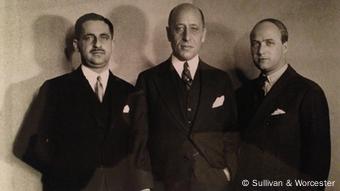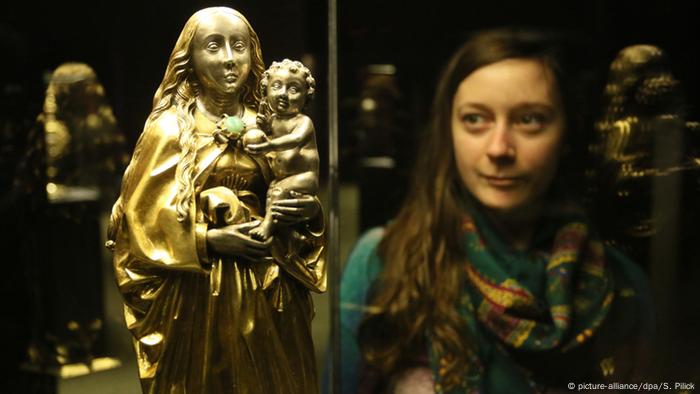Long-standing Nazi art dispute heard by US Supreme Court
Should US courts decide on the fate of the Guelph Treasure — masterpieces of medieval art acquired by the Nazis? The case could establish a precedent for many other artworks.
One of the most spectacular art litigation cases in recent history has landed at the US Supreme Court. Descendants of Jewish art dealers are suing the German government over a collection of medieval ecclesiastical artifacts known as the Guelph Treasure ("Welfenschatz"), which they claim were illegally appropriated by the Nazis.
The highest court in the United States is to determine whether the long-standing case can be pursued in the country.
A German case in the United States
Hermann Parzinger, president of the Prussian Cultural Heritage Foundation — which manages the Berlin Museum of Decorative Arts, where the collection is housed — argues that the suit should be dismissed: "Our view is that Germany is the proper jurisdiction for a case which involves the sale of a collection of medieval German art by German art dealers to a German state,'' Parzinger said in a statement.
In a brief filed before the session, the government underlined that it takes such claims seriously: "The German government has provided roughly $100 billion (in today's dollars) to compensate Holocaust survivors and other victims of the Nazi era," the brief states. The German state however argues that since the sale took place between Germans on German soil, only the German courts could rule in this case.
To decide otherwise, the brief added, "will have grave foreign policy consequences, inviting a host of lawsuits against foreign sovereigns for their domestic, sovereign acts — and may prompt other nations to reciprocate, forcing the United States to defend similar actions."
The US government supports Germany in the case.
A gift for Hitler
The Guelph Treasure comprises 44 masterpieces of medieval church art that derive from the House of Guelph (or Welf), one of the oldest princely houses in Europe that amassed extensive art collections.
Having purchased the Guelph Treasure from the Welfen family in 1929, a consortium of Jewish art dealers sold single pieces the following year, before offloading the remaining 42 gilded and bejeweled works to the Prussian state for its own collection in 1935.
Hermann Göring, the then Prime Minister of Prussia and head of the German air force, presented the treasure to Adolf Hitler as a personal gift. But the heirs of the Jewish art dealers say this present was extorted.
It is alleged, for instance, that one of the art dealers, Samy Rosenberg, received murder threats. His heirs argue that if he had not sold the treasure for the low market value set by the Nazis, he and his family would never have been taken out of Germany.
This appraisal of events was accepted by US judge Colleen Kollar-Kotelly back in 2017, who stated: "The taking of the Welfenschatz … bears a sufficient connection to genocide such that the alleged coerced sale may amount to a taking in violation of international law." Indeed, if the case comes under international law, the principle under which a sovereign state cannot be sued before the courts of another state becomes irrelevant.
A 'fair deal' in 1935?
The key question in the upcoming lawsuit is whether every possible Nazi stolen art case must be investigated in detail or whether is it sufficient to presume that after Hitler's takeover of power in 1933, Jewish art dealers were gradually disenfranchised and thus were no longer on a level playing field in the art market.
The Prussian Cultural Heritage Foundation argues with the former, claiming that an appropriate price had been paid in 1935 as a global economic crisis had depressed the art market. Parzinger said records "clearly show that there were long and tough negotiations on the price and that the two sides met exactly in the middle of their initial starting prices."
However, the art dealers' heirs argue that in 1935 it was not possible to have a "fair deal" for Jewish art dealers. They say the purchase price, 4.25 million reichsmark, was about one-third of what the collection was worth. Under international law principles, sales of property by Jews in Nazi Germany are also presumed to have been done under pressure and therefore invalid, said the heirs' attorney, Nicholas O'Donnell.
No law for stolen art cases in Germany
As early as 2008, attorneys representing the Jewish art dealers requested that the Prussian Cultural Heritage Foundation return the Guelph Treasure to the rightful owners.
But in 2015, the so-called Limbach Commission of independent experts recommended that the treasure be left in Berlin, arguing that the price paid in 1935 corresponded to the then market value. The attorneys representing the heirs of the Jewish art dealers had then said that they had no choice but to file lawsuits before a Washington DC court, since there is no legal basis for courts to consider restitution cases in Germany. The Limbach Commission can only make a recommendation that is not legally binding.
Over the years, the case made its way to the US Supreme Court, which will now hear arguments to determine whether the heirs of the collection should be allowed to continue their lawsuit in US courts. A ruling is expected by June 2021.
If US courts are found to have jurisdiction in the Guelph Treasure case, it could become the precedent for further such actions. As such, the burden of proof would no longer lie with the heirs of possibly disenfranchised art dealers or private owners. German museums would instead have to prove that they are legal owners of art works that came into their possession during the Nazi era.
Source: Long-standing Nazi art dispute heard by US Supreme Court (dw.com)




Comments